Jainism, also known as Jain Dharma, is an Indian religion. Jainism traces its spiritual ideas and history through the succession of twenty-four tirthankaras, with the first in the current time cycle being Rishabhadeva, whom the tradition holds to have lived millions of years ago, the twenty-third tirthankara Parshvanatha, whom historians date to the 9th century BCE, and the twenty-fourth tirthankara Mahavira, around 600 BCE. Jainism is considered an eternal dharma with the tirthankaras guiding every time cycle of the cosmology. The three main pillars of Jainism are ahiṃsā (non-violence), anekāntavāda (non-absolutism), and aparigraha (asceticism).
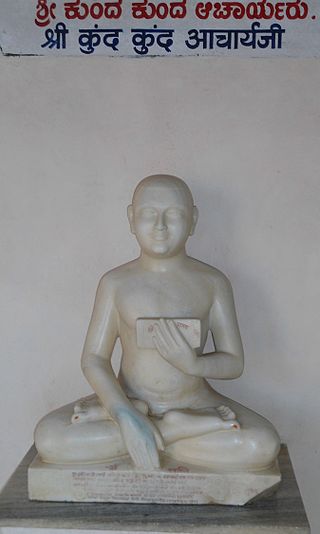
Kunda kunda was a Digambara Jain monk and philosopher, who likely lived in the second century CE or later.

Tattvārthasūtra, meaning "On the Nature [artha] of Reality [tattva]" is an ancient Jain text written by Acharya Umaswami in Sanskrit, sometime between the 2nd- and 5th-century CE.

Jain monasticism refers to the order of monks and nuns in the Jain community and can be divided into two major denominations: the Digambara and the Śvētāmbara. The monastic practices of the two major sects vary greatly, but the major principles of both are identical. Five mahāvratas, from Mahavira's teachings, are followed by all Jain ascetics of both the sects. Historians believe that a united Jain sangha (community) existed before 367 BCE, about 160 years after the moksha (liberation) of Mahavira. The community then gradually divided into the major denominations. However, no evidences indicate when the schism between the Digambaras and the Śvetāmbaras happened.

The Bhaktāmara Stotra is a Jain religious hymn (stotra) written in Sanskrit. It was authored by Manatunga. The Digambaras believe it has 48 verses while Śvetāmbaras believe it consists of 44 verses.
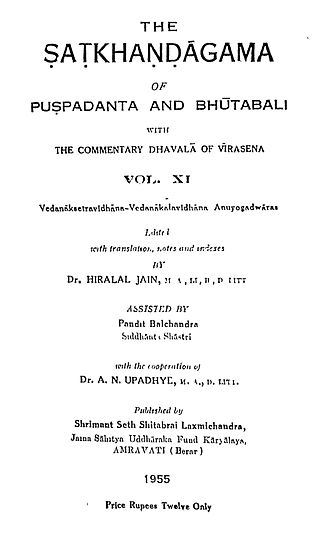
The Ṣaṭkhaṅḍāgama is the foremost and oldest Digambara Jain sacred text.
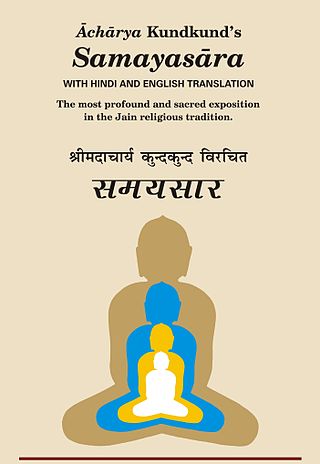
Samayasāra is a famous Jain text composed by Acharya Kundakunda in 439 verses. Its ten chapters discuss the nature of Jīva, its attachment to Karma and Moksha (liberation). Samayasāra expounds the Jain concepts like Karma, Asrava, Bandha (Bondage), Samvara (stoppage), Nirjara (shedding) and Moksha.
Siddhasēna Divākara was a Jain monk of the Śvetāmbara sect in the fifth century CE who wrote works on Jain philosophy and epistemology. He was like the illuminator of the Jain order and therefore came to be known as Divākara, "Sun". He is credited with the authorship of many books, most of which are not available. Sanmatitarka is the first major Jain work on logic written in Sanskrit. Among the most popular of his works, the Kalyan Mandir Stotra is a Sanskrit hymn dedicated to the 23rd Tirthankara Parshvanatha. It is one of the 9 holiest recitations in the Śvetāmbara Murtipujak sect of Jainism.

Acharya Pujyapada or Pūjyapāda was a renowned grammarian and acharya belonging to the Digambara tradition of Jains. It was believed that he was worshiped by demigods on the account of his vast scholarship and deep piety, and thus, he was named Pujyapada. He was said to be the guru of King Durvinita of the Western Ganga dynasty.
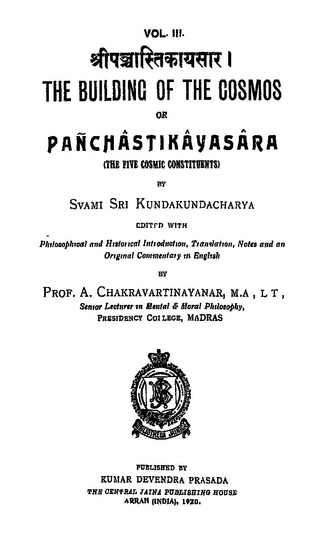
Pañcastikayasara, is an ancient Jain text authored by Acharya Kundakunda. Kundakunda explains the Jain concepts of dravya (substance) and Ethics. The work serves as a brief version of the Jaina philosophy. There are total 180 verses written in Prakrit language. The text is about five (panch) āstikāya, substances that have both characteristics, viz. existence as well as body.
Jain philosophy or Jaina philosophy refers to the ancient Indian philosophical system of the Jain religion. It comprises all the philosophical investigations and systems of inquiry that developed among the early branches of Jainism in ancient India following the parinirvāṇa of Mahāvīra. One of the main features of Jain philosophy is its dualistic metaphysics, which holds that there are two distinct categories of existence: the living, conscious, or sentient beings (jīva) and the non-living or material entities (ajīva).
Mulachara is a Jain text composed by Acharya Vattakera of the Digambara tradition, around 150 CE. Mulachara discusses anagara-dharma – the conduct of a Digambara monk. It consists twelve chapters and 1,243 verses on. It is also called Digambara Acharanga.

Jain literature refers to the literature of the Jain religion. It is a vast and ancient literary tradition, which was initially transmitted orally. The oldest surviving material is contained in the canonical Jain Agamas, which are written in Ardhamagadhi, a Prakrit language. Various commentaries were written on these canonical texts by later Jain monks. Later works were also written in other languages, like Sanskrit and Maharashtri Prakrit.
Jīva or Ātman is a philosophical term used within Jainism to identify the soul. As per Jain cosmology, jīva or soul is the principle of sentience and is one of the tattvas or one of the fundamental substances forming part of the universe. The Jain metaphysics, states Jagmanderlal Jaini, divides the universe into two independent, everlasting, co-existing and uncreated categories called the jiva (soul) and the ajiva. This basic premise of Jainism makes it a dualistic philosophy. The jiva, according to Jainism, is an essential part of how the process of karma, rebirth and the process of liberation from rebirth works.
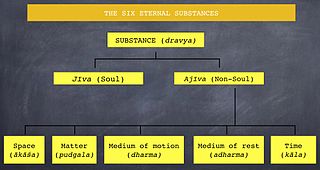
Dravya means substance or entity. According to the Jain philosophy, the universe is made up of six eternal substances: sentient beings or souls (jīva), non-sentient substance or matter (pudgala), principle of motion (dharma), the principle of rest (adharma), space (ākāśa) and time (kāla). The latter five are united as the ajiva. As per the Sanskrit etymology, dravya means substances or entity, but it may also mean real or fundamental categories.

Umaswati, also spelled as Umasvati and known as Umaswami, was an Indian scholar, possibly between 2nd-century and 5th-century CE, known for his foundational writings on Jainism. He authored the Jain text Tattvartha Sutra. Umaswati's work was the first Sanskrit language text on Jain philosophy, and is the earliest extant comprehensive Jain philosophy text accepted as authoritative by all four Jain traditions. His text has the same importance in Jainism as Vedanta Sutras and Yogasutras have in Hinduism.

Digambara is one of the two major schools of Jainism, the other being Śvetāmbara (white-clad). The Sanskrit word Digambara means "sky-clad", referring to their traditional monastic practice of neither possessing nor wearing any clothes.

Jainism is an Indian religion which is traditionally believed to be propagated by twenty-four spiritual teachers known as tirthankara. Broadly, Jainism is divided into two major schools of thought, Digambara and Śvetāmbara. These are further divided into different sub-sects and traditions. While there are differences in practices, the core philosophy and main principles of each sect is the same.
Prabhācandra was a Digambara monk,grammarian,biographer, philosopher and author of several philosophical books on Jainism.

Samantabhadra was a Digambara acharya who lived about the later part of the second century CE. He was a proponent of the Jaina doctrine of Anekantavada. The Ratnakaranda śrāvakācāra is the most popular work of Samantabhadra. Samantabhadra lived after Umaswami but before Pujyapada.













